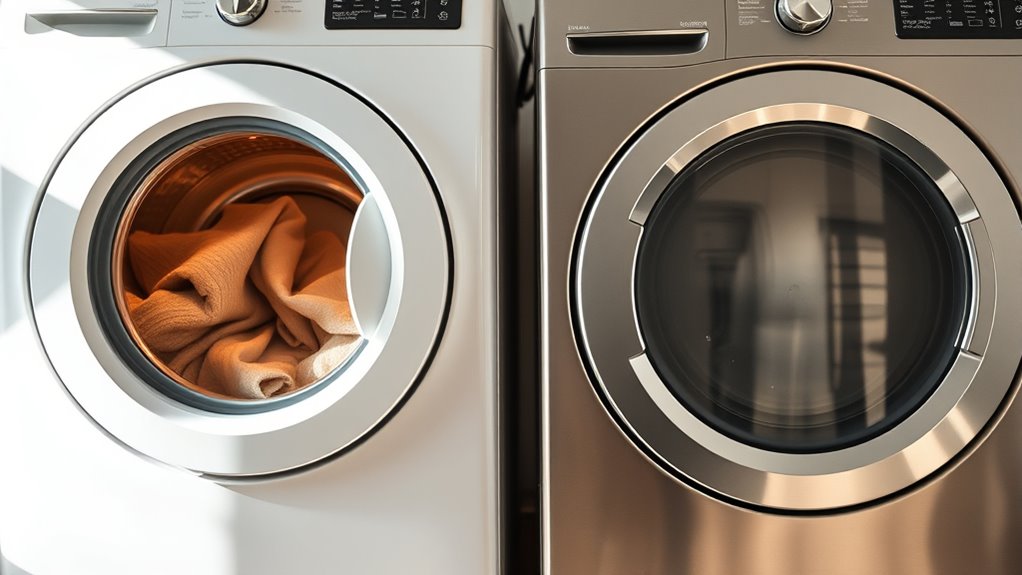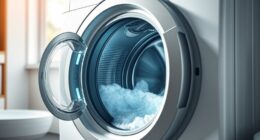Vented dryers are less eco-friendly because they use more energy and release moisture and pollutants into the environment. Condenser dryers, although using slightly more water, are generally greener since they run more efficiently and generate fewer outdoor emissions. If you want to minimize your environmental impact, choosing an energy-efficient model options and proper maintenance can make a big difference. Keep exploring to discover which type best suits your eco-conscious goals.
Key Takeaways
- Condenser dryers are generally more energy-efficient, consuming less power and emitting fewer greenhouse gases than vented models.
- Vented dryers often require less water, making them more water-conserving and environmentally friendly in that aspect.
- Condenser dryers’ closed system reduces outdoor emissions, lowering their impact on air quality and ecological footprint.
- Proper maintenance and eco-friendly usage practices can enhance the sustainability of either dryer type.
- Overall, condenser dryers tend to be greener due to higher energy efficiency and reduced outdoor environmental impact despite water use.
How Do Condenser and Vented Dryers Operate?
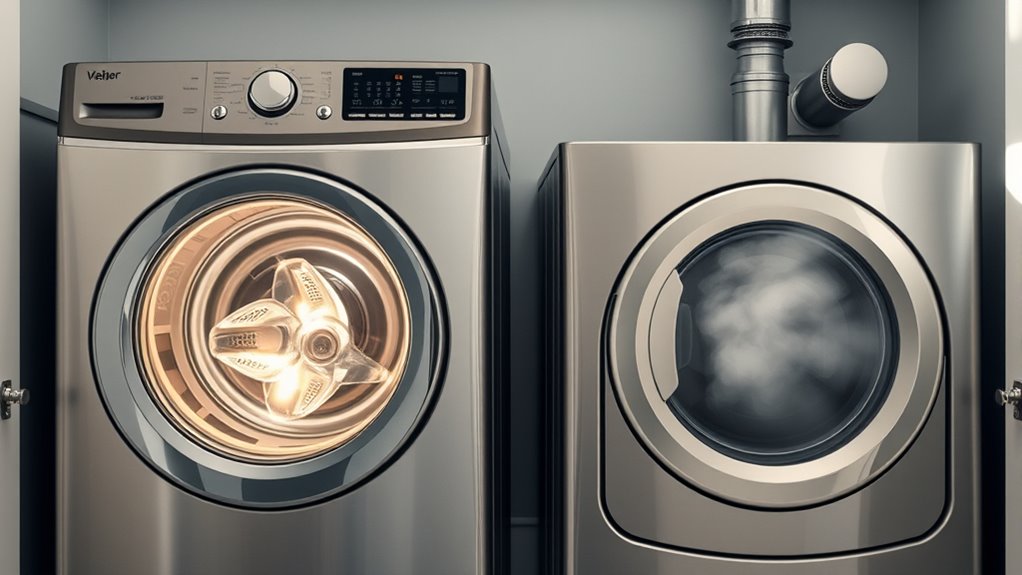
Both condenser and vented dryers work by removing moisture from your clothes, but they do so in different ways. Vented dryers expel hot, moist air outside through a duct system. As your clothes tumble, heated air absorbs moisture, which is then vented outdoors via a hose. This process requires a proper venting setup and continuous airflow. In contrast, condenser dryers don’t vent outside. Instead, they use a heat exchanger to condense moisture into water, which collects in a tray or drains away. The warm air is cooled, releasing the moisture into a reservoir. This method makes ventless operation possible without external ducts. Additionally, condenser dryers tend to be more energy-efficient in certain settings, making them a more sustainable choice for eco-conscious users. Moreover, the maintenance requirements of each type can influence their long-term sustainability and user convenience. It is also important to consider installation considerations, as condenser dryers often have a more flexible setup compared to vented models. Furthermore, the initial cost and ongoing energy consumption can vary significantly between the two, impacting their overall environmental footprint. Understanding these differences can help consumers make a more informed decision when choosing their appliance.
Energy Efficiency Comparison Between the Two Types
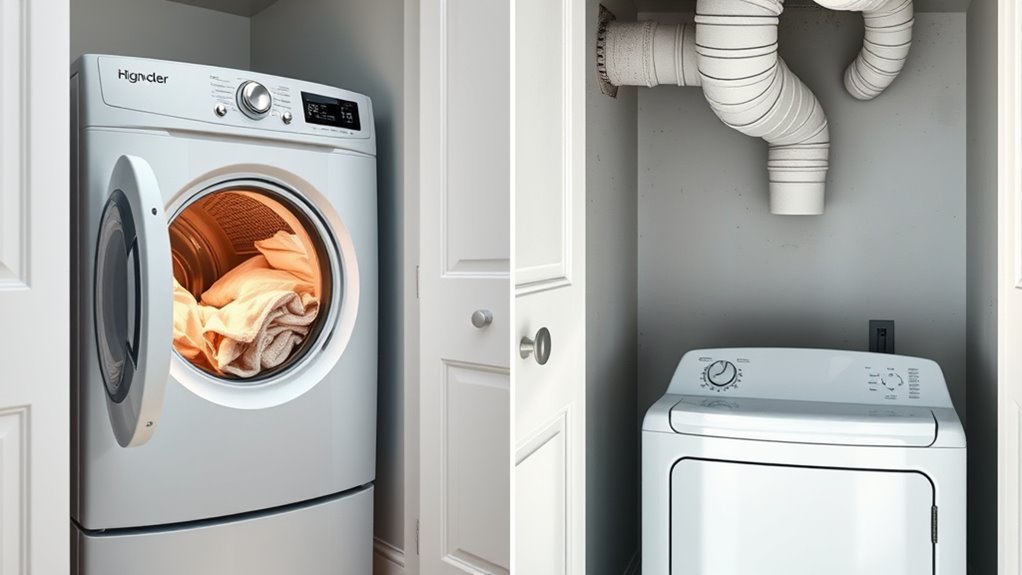
When comparing energy efficiency, condenser and vented dryers each have distinct advantages and drawbacks that can impact your utility bills. Vented dryers generally consume less energy because they use less power to dry clothes quickly, making them more cost-effective over time. However, they require proper venting, which can lead to heat loss and inefficiencies if not maintained properly. Condenser dryers tend to use more energy since they operate by condensing moisture from the air, which requires additional energy to heat and cool components. While they are often more convenient and easier to install, their longer drying cycles can lead to higher energy consumption. Ultimately, your choice depends on balancing upfront costs with ongoing energy use and efficiency.
Environmental Impact of Power Consumption
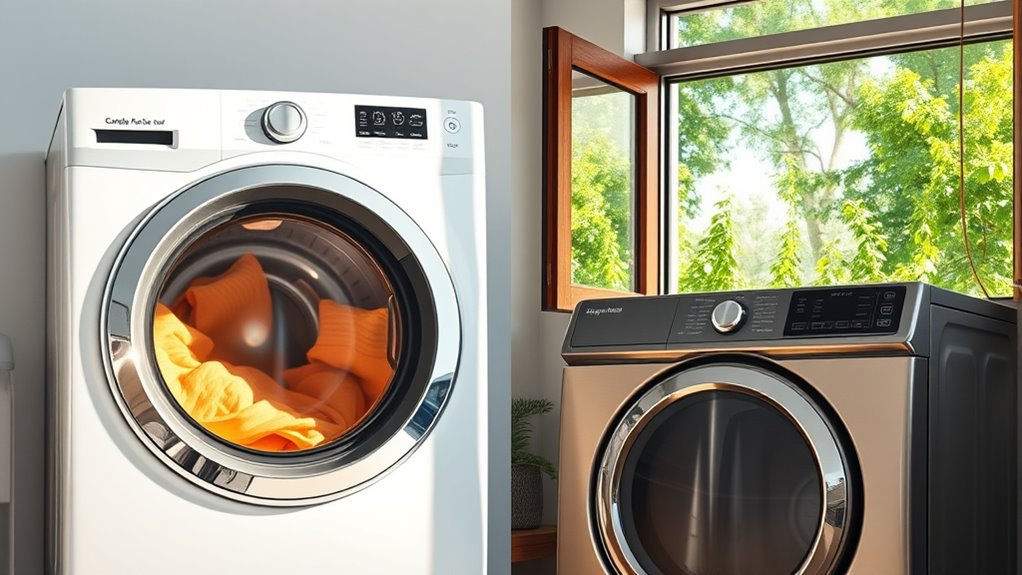
The amount of energy your dryer consumes directly impacts the environment by contributing to greenhouse gas emissions and resource depletion. When you run your dryer, it uses electricity or gas generated from fossil fuels, which releases carbon dioxide and other pollutants into the atmosphere. Higher energy consumption means more demand for power plants, increasing their environmental footprint. Vented dryers often use more energy due to heat loss and longer drying times, while condenser models may be slightly more efficient but still consume significant power. Additionally, energy-efficient appliances can help reduce overall energy use and environmental impact. By choosing an energy-efficient dryer and running full loads, you reduce your carbon footprint. Small changes in your drying habits can make a meaningful difference in decreasing overall greenhouse gas emissions and conserving natural resources. Additionally, user habits, such as selecting appropriate drying settings and maintaining your appliance, can further enhance energy efficiency.
Water Usage and Its Ecological Implications
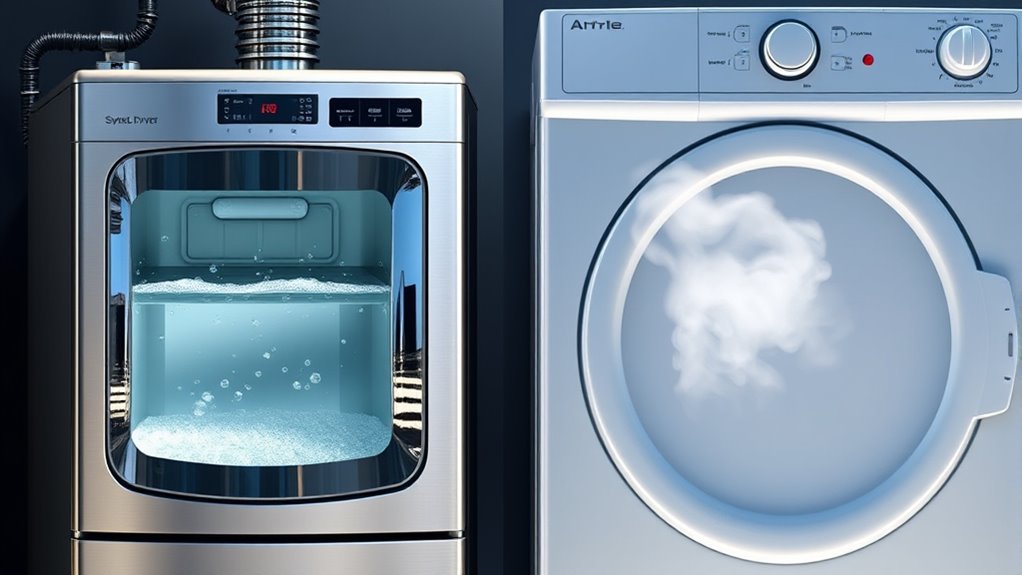
Water usage in dryers varies markedly between condenser and vented models, impacting ecological systems. Condenser dryers rely on water to condense moisture from clothes, often using several liters per load, which can strain local water resources. This extra water consumption contributes to higher water treatment demands and increases energy use in processing wastewater. Additionally, the use of water in condenser dryers can lead to greater resource depletion, affecting the sustainability of water supplies. The efficiency of water use is also influenced by the design and technology of the appliance, with some modern models incorporating water-saving features to reduce consumption. Innovations such as smart sensors help optimize water and energy use, further enhancing eco-friendliness. Modern innovations, such as energy-efficient motors, can further enhance the overall sustainability of these appliances. Vented dryers, on the other hand, do not require water for operation, making them more water-efficient. However, they release moist air into the environment, which can influence local humidity levels. If water conservation is a priority, vented models offer an advantage. But, if you’re concerned about water resource sustainability, choosing a vented dryer minimizes water consumption, helping reduce the ecological footprint associated with your laundry routine. Additionally, considering water-efficient appliances can further reduce overall water usage and environmental impact.
Maintenance and Longevity Effects on Sustainability

Maintaining your dryer regularly can extend its lifespan and improve its efficiency. Vented models often require more frequent cleaning of vents, while condenser dryers typically need less upkeep. By choosing a dryer that’s easier to maintain, you can support sustainability through reduced waste and energy use. Additionally, keeping your dryer well-maintained can prevent potential issues related to energy consumption and ensure optimal performance over time. Regular maintenance also helps mitigate security vulnerabilities that could arise from neglected components, safeguarding your appliance and data.
Ease of Maintenance
While both condenser and vented dryers require regular maintenance, condenser models generally demand more effort to keep them running efficiently over time. You’ll need to:
- Clean the lint filter frequently to prevent overheating and ensure safety.
- Empty the water reservoir regularly to maintain drying performance.
- Clear out dust and debris from internal components, which can be time-consuming.
- Inspect and clean the condenser coils to avoid energy loss and prolong the machine’s life.
Condenser dryers involve more steps, which can feel overwhelming and frustrating. However, staying on top of these tasks keeps your dryer running smoothly and extends its lifespan. Vented dryers, by comparison, are simpler, making routine maintenance less of a chore.
Durability and Lifespan
The durability and lifespan of your dryer considerably depend on how well you perform regular maintenance. By cleaning lint filters after each use and checking vents regularly, you reduce strain on the motor and prevent overheating. Condenser dryers require occasional cleaning of the condenser unit to maintain efficiency, while vented dryers benefit from clearing out ductwork to prevent blockages. Proper maintenance minimizes wear and tear, helping your dryer operate smoothly longer. Using the right settings and avoiding overloading also extend its lifespan. When you care for your dryer, you’re not only saving money on repairs and replacements but also reducing environmental impact by minimizing waste. Investing time in maintenance ensures your dryer remains reliable and eco-friendly for years to come.
Material and Manufacturing Considerations
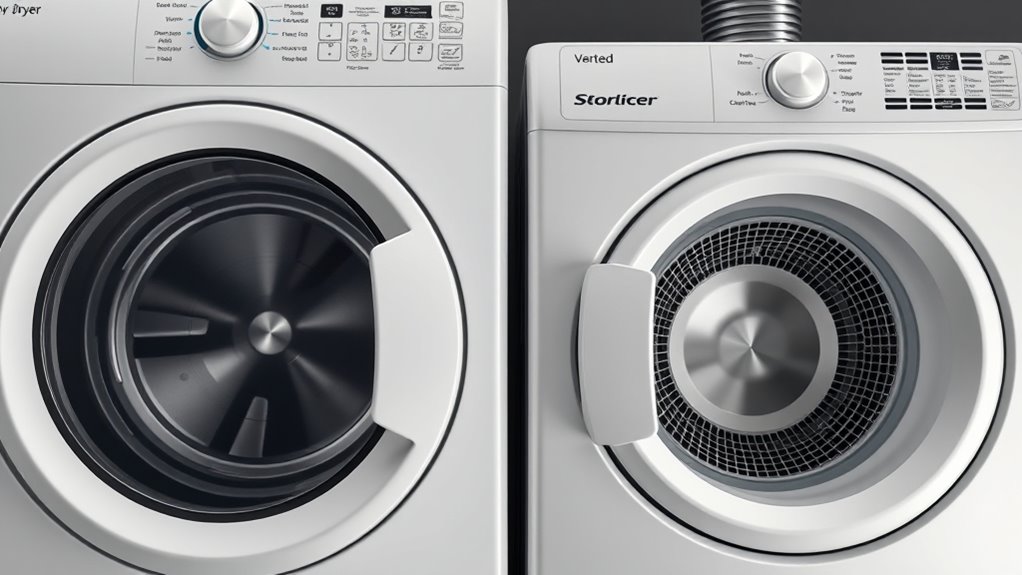
Choosing the right materials and manufacturing processes is essential for guaranteeing the durability and efficiency of both condenser and vented dryers. The choices manufacturers make impact how long your dryer lasts and how environmentally friendly it is. Consider these key factors:
- Quality components that resist corrosion and wear, reducing waste and repair needs.
- Eco-friendly materials that lower environmental impact during production and disposal.
- Efficient design techniques that minimize material waste and energy during manufacturing.
- Sustainable sourcing to ensure raw materials are responsibly harvested, supporting greener production.
- Incorporating automation’s role in business intelligence can optimize manufacturing workflows, reducing resource consumption and environmental footprint.
Cost of Operation and Long-term Expenses
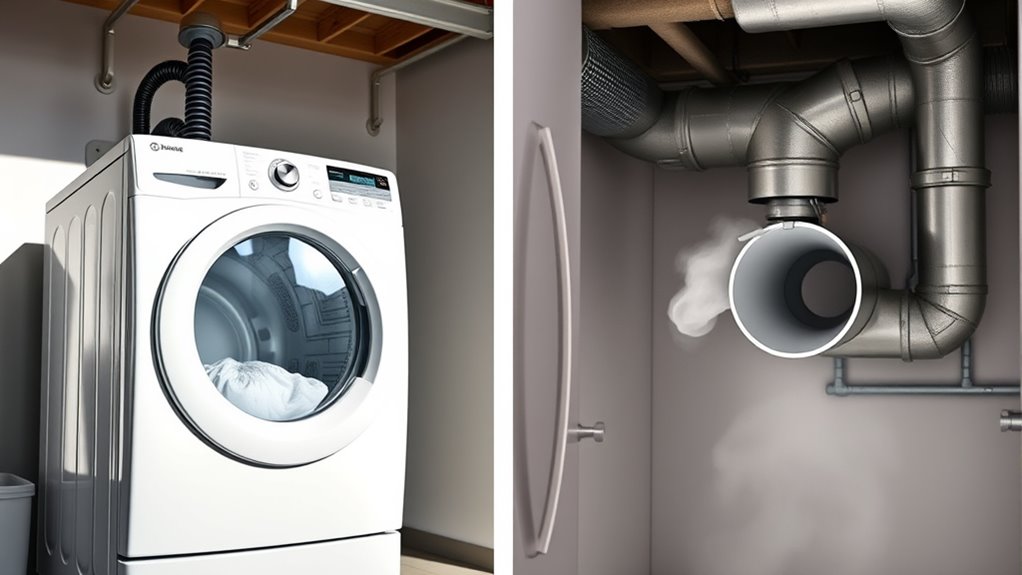
Understanding the long-term expenses of your dryer is crucial because initial purchase price isn’t the only cost to contemplate. Vented dryers typically have lower upfront costs but can incur higher energy bills over time due to less efficiency. Condenser dryers, while more expensive initially, often use less energy, saving you money monthly. You’ll also need to consider maintenance costs; condenser units may require occasional cleaning of filters and condensers, adding to ongoing expenses. Additionally, vented dryers need proper venting, which can involve installation costs or repairs if vents become clogged or damaged. Over the years, these operational costs add up, affecting your household budget. Choosing a dryer that balances upfront price with energy efficiency can lead to significant savings in the long run.
Emissions and Carbon Footprint Analysis
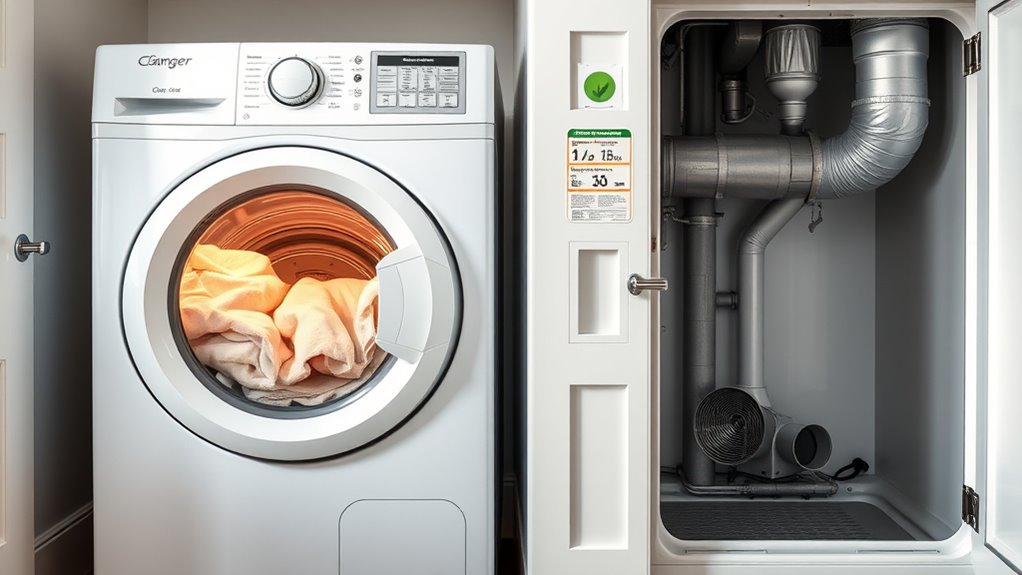
You should consider how vented and condenser dryers differ in emissions and their overall carbon footprints. Vented models often release more direct emissions, while condenser units may consume more energy, impacting their lifecycle emissions. Understanding these differences helps you choose a dryer that aligns with your environmental priorities and reduces your long-term impact. Additionally, selecting a model that is compatible with energy-efficient tuning features can further minimize its environmental footprint over time. For example, choosing models with advanced energy management capabilities can optimize power use and reduce emissions during operation. Incorporating performance upgrades such as energy-efficient motors or components can also contribute to reducing overall energy consumption and emissions.
Emission Differences Explained
While both condenser and vented dryers contribute to household energy consumption, they differ markedly in their emissions and overall carbon footprint. Vented dryers release moisture and some pollutants directly into the environment, increasing air pollution. Conversely, condenser dryers emit fewer pollutants because they operate with closed systems, reducing outdoor emissions. Consider these points:
- Vented dryers release greenhouse gases linked to higher air pollution.
- Condenser dryers produce lower emissions but consume more electricity.
- The increased energy use of condensers can offset their cleaner emissions.
- Your choice impacts not just your home’s footprint but also local air quality and global climate health.
Understanding these differences helps you make smarter, greener decisions for your laundry routine.
Energy Consumption Impact
Although condenser dryers emit fewer pollutants, they tend to consume more electricity than vented models, considerably impacting their overall environmental footprint. This higher energy use means you’ll likely produce more carbon emissions depending on your electricity source. Vented dryers, while emitting more pollutants locally, often operate more efficiently in energy terms, consuming less power per cycle. However, if your electricity comes from fossil fuels, increased energy consumption can lead to a larger carbon footprint for condenser models. Your choice influences not only local air quality but also the global impact of your appliance usage. To minimize your environmental impact, consider both the energy efficiency of the dryer and the carbon intensity of your power grid. Ultimately, energy consumption plays a significant role in determining which dryer is greener for your circumstances.
Lifecycle Emission Considerations
When evaluating the true environmental impact of condenser and vented dryers, it’s essential to take into account their entire lifecycle emissions. From manufacturing to disposal, each phase adds to their carbon footprint. Consider these key points:
- Manufacturing emissions: Extracting raw materials and building the units consume significant energy, impacting the environment from the start.
- Operational energy: Even if a dryer uses less electricity, frequent use accumulates emissions over its lifespan.
- Maintenance and repairs: Parts replacement and servicing generate additional emissions, extending the environmental cost.
- End-of-life disposal: Recycling or landfill disposal releases greenhouse gases and wastes valuable resources.
Understanding these stages helps you see the full picture and make a greener choice that minimizes long-term ecological harm.
Practical Usage Tips for Eco-Friendly Drying

To maximize eco-friendly drying, you should start by properly sorting your laundry and choosing the right settings on your dryer. Separate heavy items like towels and jeans from lighter fabrics to ensure efficient drying times. Use the sensor-dry or eco mode options, which automatically adjust drying time to prevent over-drying and save energy. Avoid overloading the dryer, as this can reduce airflow and prolong drying cycles. Remove clothes promptly once dry to prevent wrinkles and unnecessary energy use from re-drying. Regularly clean the lint filter to maintain airflow and efficiency. Consider air-drying clothes when possible, especially for items that don’t need to be fully dry. Implementing these tips helps reduce energy consumption and lowers your environmental impact.
Making the Green Choice: Factors to Consider

Choosing the most eco-friendly dryer involves evaluating several key factors. First, consider energy efficiency—look for models with high energy ratings to reduce your carbon footprint. Second, assess water usage; condenser dryers often use more water, which can impact sustainability. Third, think about lifespan and durability—long-lasting appliances prevent waste and reduce manufacturing impacts. Fourth, factor in your local climate and ventilation options—vented dryers need proper exhaust, while condensers are more versatile everywhere. By weighing these elements, you make a conscious choice that aligns with your environmental values. Your decision can lower energy bills and lessen environmental harm. Remember, small choices in appliance selection can lead to significant, positive impacts for the planet.
Frequently Asked Questions
Which Dryer Type Has a Smaller Overall Environmental Footprint?
You want to know which dryer type has a smaller environmental footprint. Generally, condenser dryers are more energy-efficient because they recycle heat, reducing electricity use. Vented dryers release warm, moist air outside, which can be less efficient and waste energy. By choosing a condenser dryer, you can lower your carbon footprint, save on energy costs, and contribute to a more sustainable environment.
Can Vented Dryers Be Upgraded to Be More Eco-Friendly?
You can upgrade vented dryers to be more eco-friendly by installing venting systems that improve airflow efficiency, using eco-friendly drying modes, and maintaining the vents regularly to prevent energy loss. Switching to a more energy-efficient model or adding a moisture sensor can also reduce power consumption. Although these upgrades help, considering a switch to a condenser dryer might be a better long-term solution for reducing your environmental impact.
How Do Manufacturing Practices Affect the Sustainability of Each Dryer Type?
You might think manufacturing is all about making stuff, but it’s actually a big eco-scorecard. For vented dryers, the focus on lightweight plastics and metal parts can mean less resource use, but sometimes at the cost of durability. Condenser dryers often require more complex components, which can increase their carbon footprint during production. So, depending on how they’re made, each type can tip the sustainability scales in surprising ways.
Are There Eco-Friendly Alternatives to Traditional Condenser and Vented Dryers?
You’re wondering if eco-friendly options exist beyond traditional dryers. Yes, you can choose energy-efficient models like heat pump dryers, which use less electricity and produce fewer emissions. Solar-powered dryers are another alternative, harnessing renewable energy. Additionally, line drying or using drying racks reduces energy consumption altogether. While these options may cost more upfront, they help you cut down your environmental impact and lower your energy bills over time.
How Does the Recyclability of Materials Impact the Environmental Benefits of Each Dryer?
You consider how the recyclability of materials affects each dryer’s environmental impact. When you choose a dryer made with easily recyclable parts, you help reduce waste and promote sustainability. Condenser dryers often use plastics and metals that can be recycled, while vented dryers may involve more durable, less recyclable materials. By prioritizing recyclability, you make an eco-friendly choice that minimizes landfill waste and supports a greener future.
Conclusion
Choosing between condenser and vented dryers isn’t just about cost or convenience—it’s about your environmental impact. While vented models might seem more eco-friendly due to lower energy use, they require outdoor venting, which isn’t always feasible. Condenser dryers, though slightly less efficient, offer a more sustainable option for apartments or spaces without vents. By considering your living situation and eco goals, you can make a greener choice that fits your lifestyle and helps protect the planet.
